Soil/Landform Unit - Neuarpur undulating plains
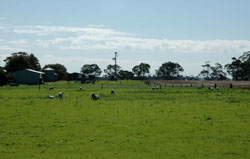 Plains with subdued ridges cleared for grazing and cropping |
0.73% of CMA region Undulating plains on the border of Victoria and South Australia comprise plains, dunes and swamps south of the Little Desert. Part of the North West Dunefields and Plains, the plains consist of grey and brown cracking clay soils (Vertosols) on the plains, sodic brown, yellow and grey texture contrast soils (Sodosols) on the rises and seasonally wet texture contrast soils (Hydrosols) in swamps. Soils can be susceptible to seasonal and periodic inundation/waterlogging in swamps and plains, but can be variable due to micro relief (gilgai). Land use is mainly cereal cropping, fodder production and grazing (sheep). Vegetation is dominated by woodland vegetation such as Low Rises Woodland, Plains Woodland and Shallow Sands Woodland. Other vegetation communities present include Red Gum Wetland and Plains Savannah. | 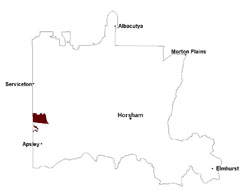 |
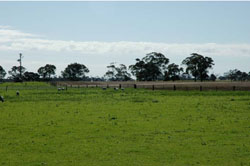 Subdued ridge used for combination farming practices | 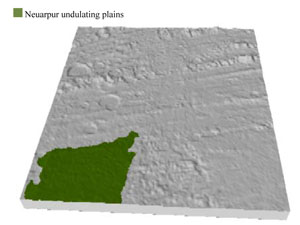 |
 | 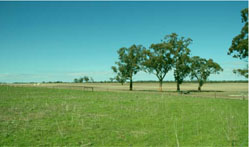 Fallow paddock near Tallageira |
Component | 1 | 2 | 3 |
Proportion of soil-landform unit | 70% | 30% | 10% |
| CLIMATE Rainfall (mm) | Annual: 540 | ||
| Temperature (oC) | Minimum 8, Maximum 21 | ||
| Precipitation less than potential evapotranspiration | September–April | ||
| GEOLOGY Age and lithology | Quaternary paludal silt and clay; Neogene marine sand and silt (Parilla Sand) | ||
| Geomorphology | |||
| LANDUSE | Uncleared areas: Nature conservation Cleared areas: Dryland cropping; sheep grazing | ||
| TOPOGRAPHY Landscape | Undulating plains | ||
| Elevation range (m) | 96–131 | ||
| Local relief (m) | 3 | ||
| Drainage pattern | Dendritic | ||
| Drainage density (km/km2) | 0.2 | ||
| Landform | Plains | ||
| Landform element | Plain | Dune slope | Swamp |
| Slope and range (%) | 3 (1-7) | 5 (3-10) | 1 (0-4) |
| Slope shape | Convex | Convex | Concave |
| NATIVE VEGETATION Ecological Vegetation Class | Plains Woodland (66.8%), Plains Savannah (10.5%), Shallow Sands Woodland (9.7%), Other (10.5%) | ||
| SOIL Parent material | Paludal silt and clay, marine sand and silt | Marine sand and silt | Paludal silt and clay |
| Description (Corangamite Soil Group) | Grey and brown cracking clay soils (37) | Sodic brown, yellow and grey texture contrast soils (38) | Seasonally wet soils: sodic yellow and grey texture contrast soils (33) and grey and brown cracking clay soils (37) |
| Soil type sites | LS3, LSWW9, LSWW5 | LSWW11, LSWW17, LSWW13 | |
| Surface texture | Medium clay | Loamy sand | Sandy clay loam to light clay |
| Permeability | Slow | Moderate | Very slow |
| Depth (m) | > 2 | 1.3 | > 2 |
| LAND CHARACTERISTICS, POTENTIAL AND LIMITATIONS Critical land features, processes, forms | Susceptible to inundation and waterlogging in lower areas, but can be variable due to micro relief (gilgai). Surface soils friable and only slightly susceptible to wind erosion. Soils susceptible to compaction at critical moisture contents. | Susceptible to wind and sheet erosion where surfaces with little organic matter are exposed. Susceptible to compaction where hardsetting and restricted drainage. Upper soil is susceptible to acidification. | Susceptible to seasonal inundation, waterlogging and ultimately soil salinity. Upper soils susceptible to sheet erosion and wind erosion when exposed. Soils susceptible to compaction at critical moisture contents. |


